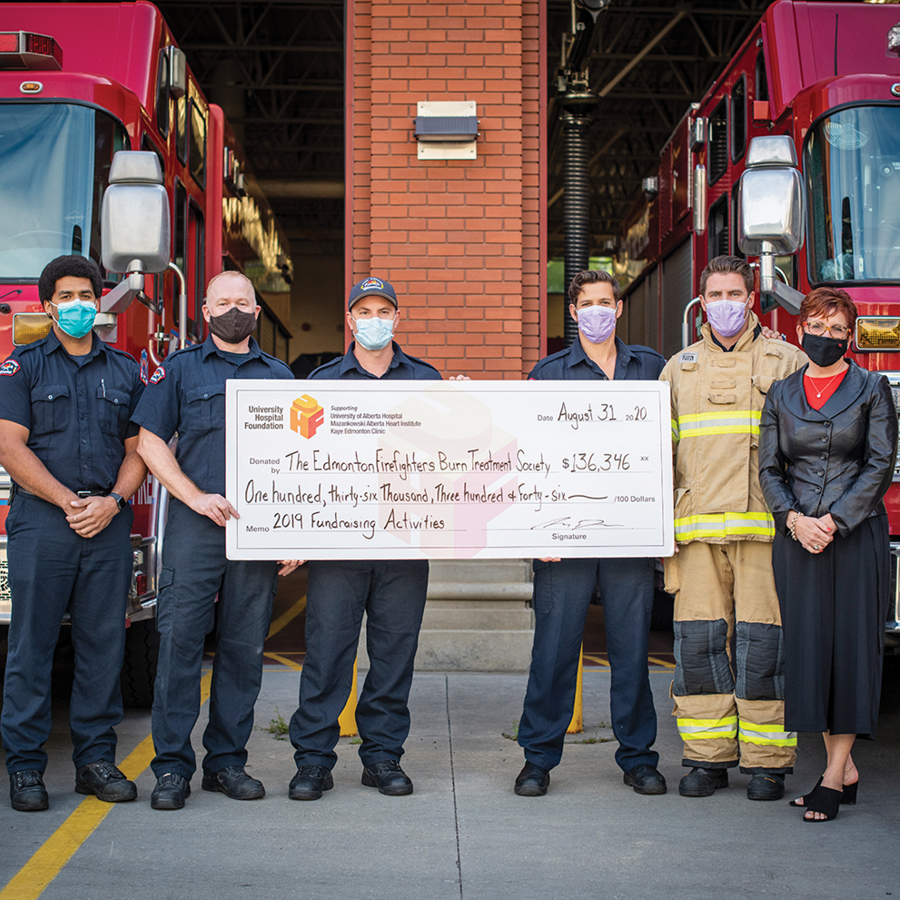- 1-833-448-3843 Make a call.
- info@givetouhf.ca Drop us an email.
- We are located in Edmonton, Alberta
Heroes. Models. Fundraisers.
Firefighters are heroes, racing to situations the rest of us try desperately to escape.

From left to right: Curtis Moss, James Bruce, Andy Dryer, Trevor Brophy, Thomas Carr, Dr. Jodi L. Abbott
WHAT THEY SEE in the aftermath of a five-alarm blaze or horrific workplace accident can be heartstopping – people of all ages ravaged by burns to all parts of their bodies.
The recovery process from severe burns is painfully long and full of infection risks that can prolong the already-arduous journey.
So the firefighters do something about it. They raise money to support the doctors and medical teams who care for burn survivors. And they have fun doing it because… why not?
Over the last 10 years, the Edmonton Firefighters Burn Treatment Society (EFBTS) has donated over $2.5 million to the University Hospital Foundation in support of the University of Alberta Hospital’s Firefighters’ Burn Treatment Unit, regarded as one of the best in Canada.
Since its incorporation in 1977, the EFBTS has donated close to $13 million to the University Hospital Foundation, including gifts-in-kind.
James Bruce, Chairman of the EFBTS and a firefighter himself, says the desire to reach out and do more to help burn survivors is a natural consequence of the profession. “We’ve all seen what fire can do to a person. I’ve been burned myself when I was working in the trades. I was lucky to receive quick, effective treatment that greatly minimized scarring.”
Most of the money they raise is through golf tournaments and sales of their ‘Turn up the Heat’ firefighters’ calendar, featuring female and male firefighters from Edmonton and surrounding areas.
“It’s a fun way of raising money for a very serious cause,” says Bruce of the calendar. “We keep it professional, but we have a good time. People love it.”
Funds raised support all aspects of burn treatment care, as well as the Alberta Fire Fighters’ Burn Camp for Children, an annual, week-long camp for 70 burn survivors between the ages of seven and 17.
“Doctors, nurses and firefighters from across Alberta get together to organize and run the camp,” says Bruce. “Our goal is to make sure camp is always free of charge to every camper. The average cost per camper is about $1,000. We’re about 60 per cent of the way to our goal.” The camp was put on hold this year due to the pandemic and vulnerability of young burn survivors, so the EFBTS had to pivot and get creative with its fundraising efforts – it is hoping to increase the amount of funds raised through calendar sales so it is able to recoup and funds normally raised to put on the camp. With the support of the University Hospital Foundation, friendships with fire departments and private companies across Alberta and beyond – James is confident Edmontonians will help in any way they can.
Dr. Ted Tredget, Director of the Firefighters’ Burn Treatment Unit, says financial support from the EFBTS has led to advancements in patient care today for the 150-200 burn patients of all ages the unit cares for each year. The funding is also helping to develop and improve burn treatment and recovery in the future.
“We do a lot of research in a variety of areas in burn treatment. Right now, I’m involved in a study that’s looking at reducing the impact of scarring and scar tissue on burn survivors. Severe scarring can distort your facial features or limit your range of motion and function, say, in your hands if you’re a carpenter or electrician. We’d like to restore the healed wound to a normal condition, and avoid successive scarring.
“It’s probably the leading post-recovery complication that burn patients have that compromises their quality of life.”
Thanks to the fundraising efforts of Edmonton’s firefighters, and killer abs, research and patient care at one of Canada’s top burn treatment units will only get better.
